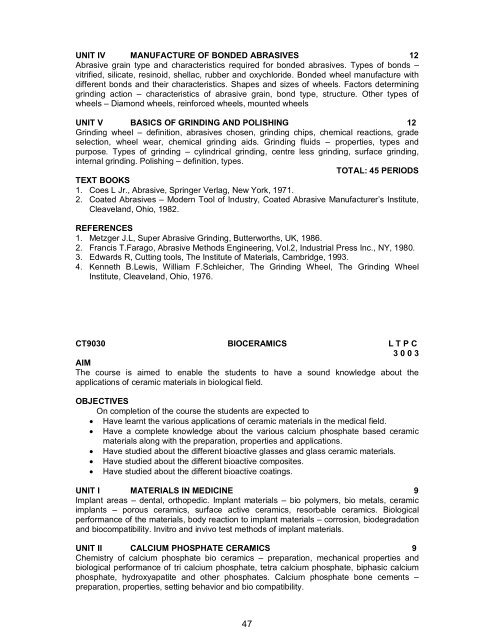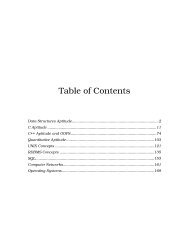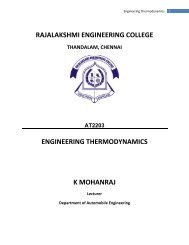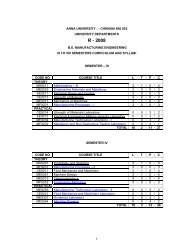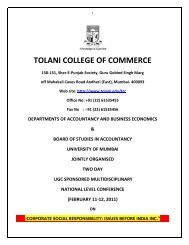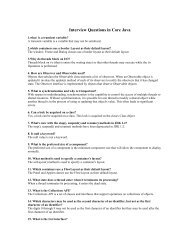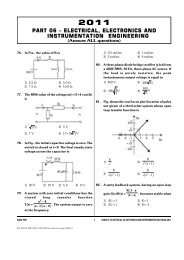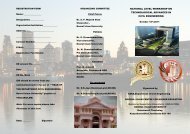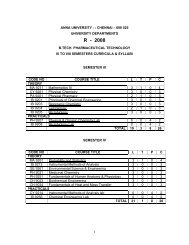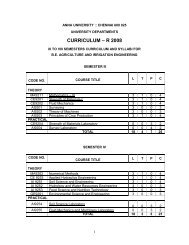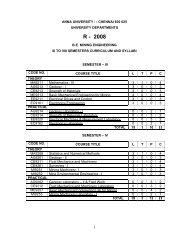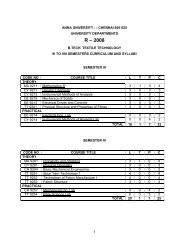b.tech. ceramic technology - Technicalsymposium
b.tech. ceramic technology - Technicalsymposium
b.tech. ceramic technology - Technicalsymposium
Create successful ePaper yourself
Turn your PDF publications into a flip-book with our unique Google optimized e-Paper software.
UNIT IV MANUFACTURE OF BONDED ABRASIVES 12Abrasive grain type and characteristics required for bonded abrasives. Types of bonds –vitrified, silicate, resinoid, shellac, rubber and oxychloride. Bonded wheel manufacture withdifferent bonds and their characteristics. Shapes and sizes of wheels. Factors determininggrinding action – characteristics of abrasive grain, bond type, structure. Other types ofwheels – Diamond wheels, reinforced wheels, mounted wheelsUNIT V BASICS OF GRINDING AND POLISHING 12Grinding wheel – definition, abrasives chosen, grinding chips, chemical reactions, gradeselection, wheel wear, chemical grinding aids. Grinding fluids – properties, types andpurpose. Types of grinding – cylindrical grinding, centre less grinding, surface grinding,internal grinding. Polishing – definition, types.TOTAL: 45 PERIODSTEXT BOOKS1. Coes L Jr., Abrasive, Springer Verlag, New York, 1971.2. Coated Abrasives – Modern Tool of Industry, Coated Abrasive Manufacturer’s Institute,Cleaveland, Ohio, 1982.REFERENCES1. Metzger J.L, Super Abrasive Grinding, Butterworths, UK, 1986.2. Francis T.Farago, Abrasive Methods Engineering, Vol.2, Industrial Press Inc., NY, 1980.3. Edwards R, Cutting tools, The Institute of Materials, Cambridge, 1993.4. Kenneth B.Lewis, William F.Schleicher, The Grinding Wheel, The Grinding WheelInstitute, Cleaveland, Ohio, 1976.CT9030 BIOCERAMICS L T P C3 0 0 3AIMThe course is aimed to enable the students to have a sound knowledge about theapplications of <strong>ceramic</strong> materials in biological field.OBJECTIVESOn completion of the course the students are expected to Have learnt the various applications of <strong>ceramic</strong> materials in the medical field. Have a complete knowledge about the various calcium phosphate based <strong>ceramic</strong>materials along with the preparation, properties and applications. Have studied about the different bioactive glasses and glass <strong>ceramic</strong> materials. Have studied about the different bioactive composites. Have studied about the different bioactive coatings.UNIT I MATERIALS IN MEDICINE 9Implant areas – dental, orthopedic. Implant materials – bio polymers, bio metals, <strong>ceramic</strong>implants – porous <strong>ceramic</strong>s, surface active <strong>ceramic</strong>s, resorbable <strong>ceramic</strong>s. Biologicalperformance of the materials, body reaction to implant materials – corrosion, biodegradationand biocompatibility. Invitro and invivo test methods of implant materials.UNIT II CALCIUM PHOSPHATE CERAMICS 9Chemistry of calcium phosphate bio <strong>ceramic</strong>s – preparation, mechanical properties andbiological performance of tri calcium phosphate, tetra calcium phosphate, biphasic calciumphosphate, hydroxyapatite and other phosphates. Calcium phosphate bone cements –preparation, properties, setting behavior and bio compatibility.47


